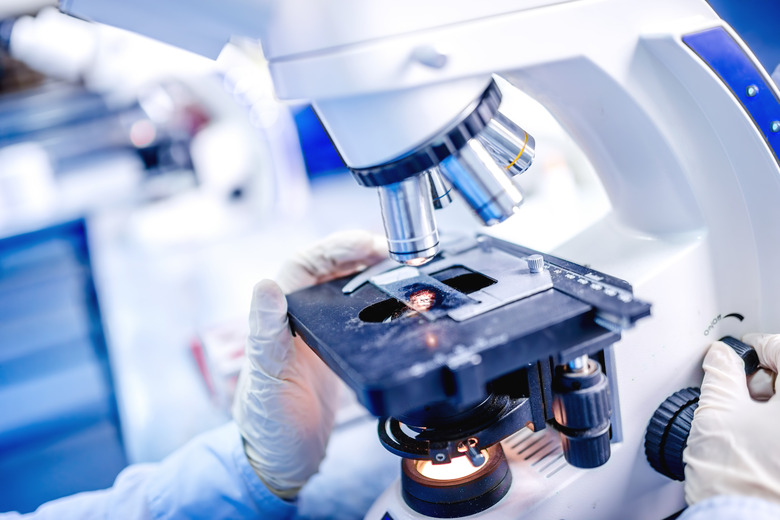What Happens To Cells Due To A Sodium Imbalance?
Most of a cell's volume is composed of water. A sodium imbalance could cause water to rush across the cell plasma membrane in either direction. Too little water makes the cell shrivel up; too much water makes it burst. The balance between water and electrolytes, such as sodium, controls cell integrity. Electrolytes determine the action potential across cell membranes. Action potential is the shifting electrical charge that determines a cell's ability to regulate its fluid volume, exchange waste for fuel and respond to nerve impulses. Sodium is the most abundant electrolyte, and is therefore essential to a cell's function.
TL;DR (Too Long; Didn't Read)
Cells are basically membrane-bound sacks of fluid, existing within bodies of fluid. Cells' functions rely on their ability to regulate this fluid. Electrolytes are molecules that influence cell fluid regulation. Sodium is the most abundant electrolyte. Too much sodium in the surrounding fluid – or too little in the cells – sucks too much water out of the cells. These dehydrated cells and their organelles shrink, crushing vital internal machinery. Too little sodium in the surrounding fluid – or too much within the cells -causes cells to swell as their higher sodium concentration draws too much water in, which eventually causes cell and organelle membranes to burst. A sodium imbalance will paralyze the cells' transport and communication systems and kill the organism.
Sacks of Water
Sacks of Water
Cells are basically tiny, membrane-bound sacks of fluid. Most single-celled organisms live in fluid, while most cells within multicellular organisms exist awash in body fluids. Cells' functions rely on their ability to regulate this fluid. Electrolytes are molecules that influence cell fluid regulation. The concentration of electrolytes is called osmolarity, which means the amount of a solute, or dissolved substance, per unit of liquid. Sodium is the most abundant electrolyte within organisms, so it determines the osmolarity.
Too Much Sodium
Too Much Sodium
Sodium plays an important role in maintaining cell volume. There has to be enough sodium both within and outside the cell to keep necessary fluid in and excess fluid out. Too much sodium in the surrounding body fluid – or too little in the cells – is called hypernatremia. In hypernatremia, the excess sodium in the body fluid sucks too much water out of the cells. These dehydrated cells and their organelles shrink, crushing vital internal machinery.
Too Little Sodium
Too Little Sodium
Too little sodium in the surrounding fluid – or too much within the cells – is called hyponatremia. When excessive water increase outside the cell causes hyponatremia, it's called euvolemia; when water and sodium levels both increase but water increases more, it's called hypervolemia. When loss of both fluid and sodium results in a hyponatremic imbalance, it's called hypovolemic hyponatremia. In all of these cases, hyponatremic cells swell as their higher sodium concentration draws too much water in, which eventually causes cell and organelle membranes to burst, spilling the contents into the surrounding environment and killing the cell.
Broken Pump
Broken Pump
The sodium-potassium pump is the locus of a constant exchange of electrical charge across cell membranes. It trades positively charged sodium ions for negatively charged potassium ones and allows the transfer of substances across cell membranes. The sodium-potassium pump also generates the electrical impulses necessary for nerve signals. Sodium imbalances interfere with this exchange and with the ability to receive and transmit signals. If the interference is great enough or lasts long enough, the sodium imbalance will paralyze the cells' transport and communication systems and kill the organism.
Cite This Article
MLA
Libal, Angela. "What Happens To Cells Due To A Sodium Imbalance?" sciencing.com, https://www.sciencing.com/happens-cells-due-sodium-imbalance-20991/. 14 May 2018.
APA
Libal, Angela. (2018, May 14). What Happens To Cells Due To A Sodium Imbalance?. sciencing.com. Retrieved from https://www.sciencing.com/happens-cells-due-sodium-imbalance-20991/
Chicago
Libal, Angela. What Happens To Cells Due To A Sodium Imbalance? last modified March 24, 2022. https://www.sciencing.com/happens-cells-due-sodium-imbalance-20991/
